SOCA6571 - Analyzing Modernization and Dependency Theories: Semester 1
VerifiedAdded on 2023/06/07
|13
|3581
|164
Essay
AI Summary
This essay provides a detailed comparison of Modernization and Dependency theories, examining their origins, assumptions, similarities, and differences. Modernization theory posits that traditional societies can develop by adopting modern practices, while Dependency theory argues that wealthy nations exploit poorer ones. The essay explores the strengths and weaknesses of both theories, highlighting the advantages and disadvantages of modernization, such as technological advancement versus the exploitation of the poor. It also discusses the criticisms of both theories, including the top-down approach of Modernization theory and the potential for stifled competition under Dependency theory. Ultimately, the essay analyzes which theory best describes the contemporary global situation based on their respective merits and drawbacks.
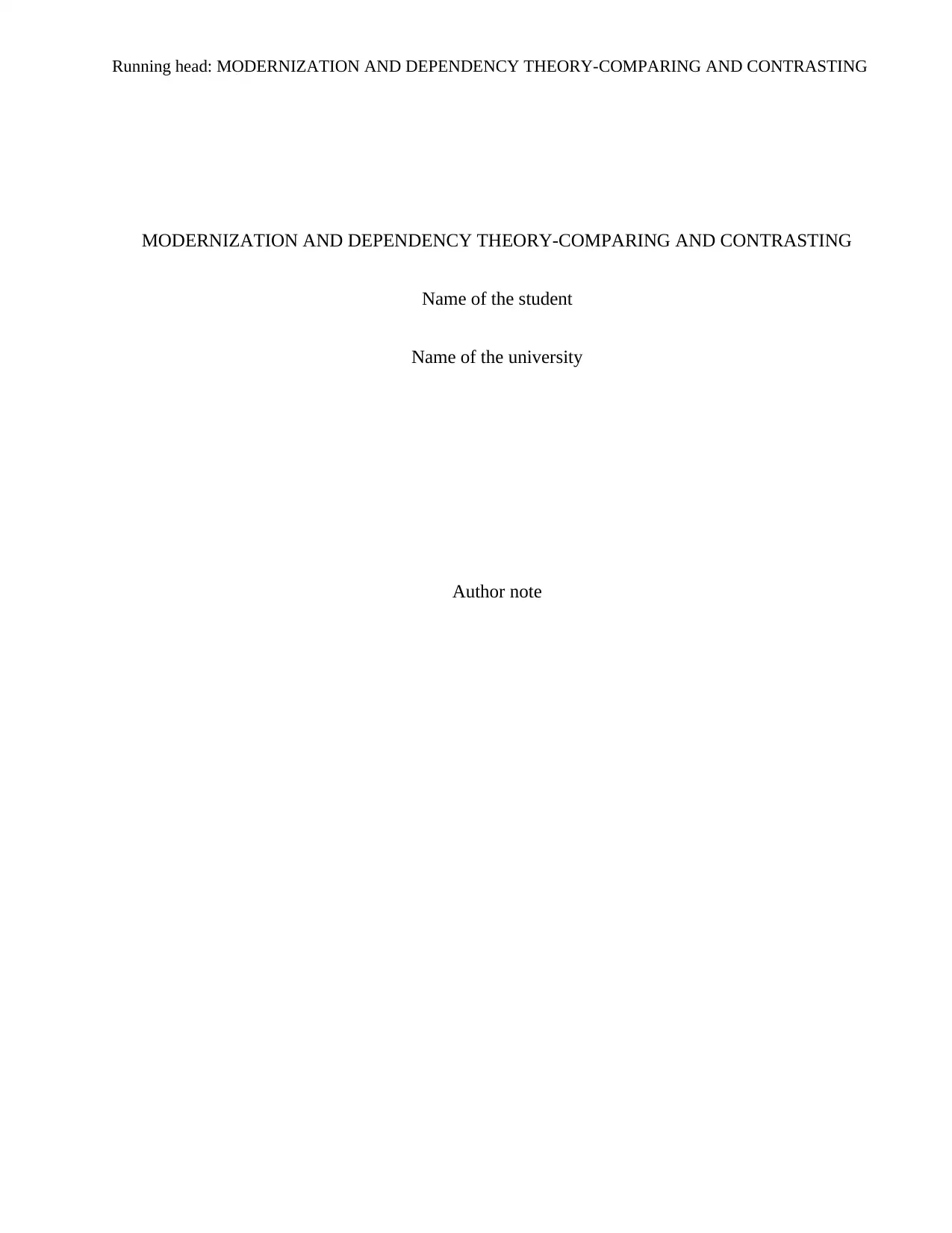
Running head: MODERNIZATION AND DEPENDENCY THEORY-COMPARING AND CONTRASTING
MODERNIZATION AND DEPENDENCY THEORY-COMPARING AND CONTRASTING
Name of the student
Name of the university
Author note
MODERNIZATION AND DEPENDENCY THEORY-COMPARING AND CONTRASTING
Name of the student
Name of the university
Author note
Paraphrase This Document
Need a fresh take? Get an instant paraphrase of this document with our AI Paraphraser
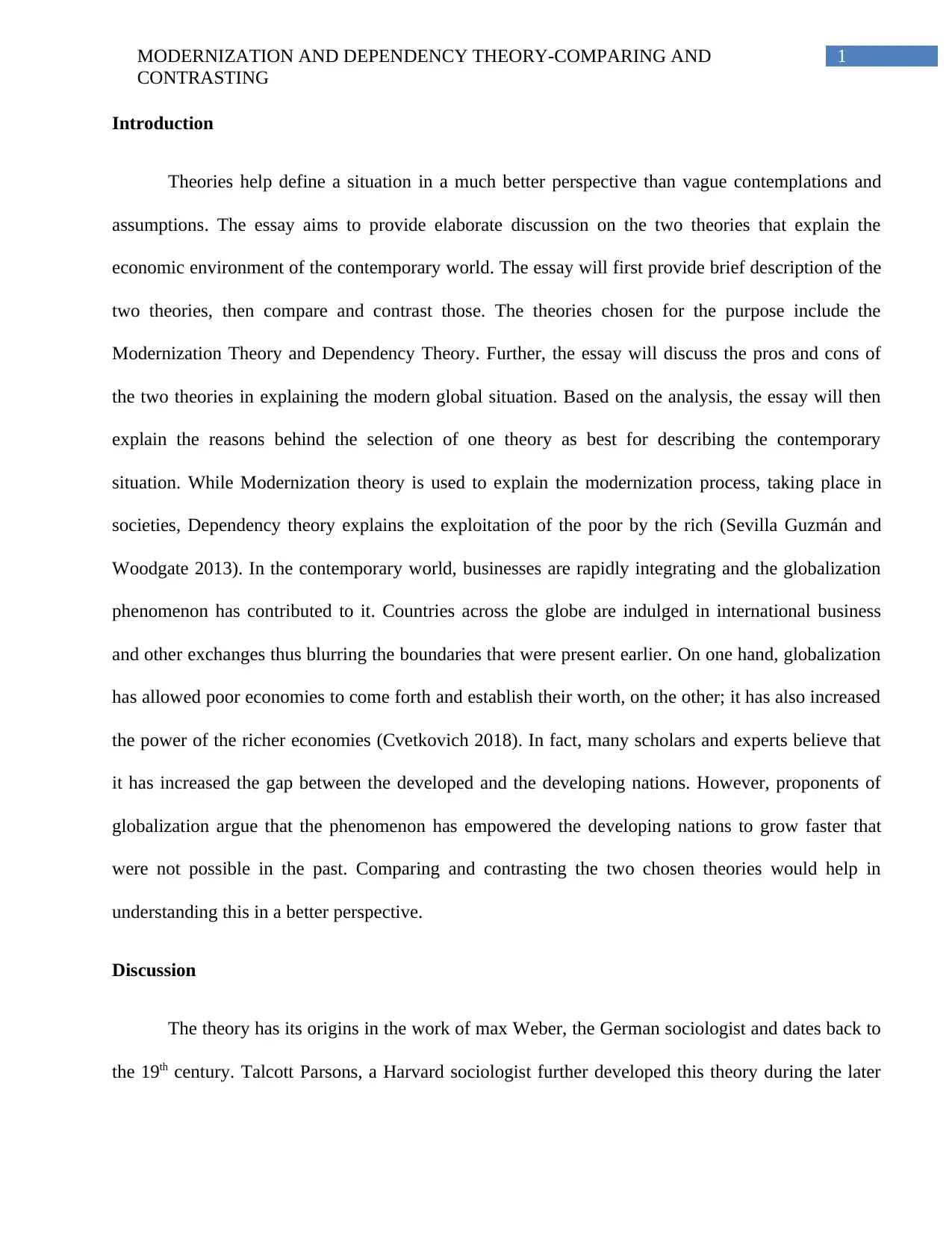
1MODERNIZATION AND DEPENDENCY THEORY-COMPARING AND
CONTRASTING
Introduction
Theories help define a situation in a much better perspective than vague contemplations and
assumptions. The essay aims to provide elaborate discussion on the two theories that explain the
economic environment of the contemporary world. The essay will first provide brief description of the
two theories, then compare and contrast those. The theories chosen for the purpose include the
Modernization Theory and Dependency Theory. Further, the essay will discuss the pros and cons of
the two theories in explaining the modern global situation. Based on the analysis, the essay will then
explain the reasons behind the selection of one theory as best for describing the contemporary
situation. While Modernization theory is used to explain the modernization process, taking place in
societies, Dependency theory explains the exploitation of the poor by the rich (Sevilla Guzmán and
Woodgate 2013). In the contemporary world, businesses are rapidly integrating and the globalization
phenomenon has contributed to it. Countries across the globe are indulged in international business
and other exchanges thus blurring the boundaries that were present earlier. On one hand, globalization
has allowed poor economies to come forth and establish their worth, on the other; it has also increased
the power of the richer economies (Cvetkovich 2018). In fact, many scholars and experts believe that
it has increased the gap between the developed and the developing nations. However, proponents of
globalization argue that the phenomenon has empowered the developing nations to grow faster that
were not possible in the past. Comparing and contrasting the two chosen theories would help in
understanding this in a better perspective.
Discussion
The theory has its origins in the work of max Weber, the German sociologist and dates back to
the 19th century. Talcott Parsons, a Harvard sociologist further developed this theory during the later
CONTRASTING
Introduction
Theories help define a situation in a much better perspective than vague contemplations and
assumptions. The essay aims to provide elaborate discussion on the two theories that explain the
economic environment of the contemporary world. The essay will first provide brief description of the
two theories, then compare and contrast those. The theories chosen for the purpose include the
Modernization Theory and Dependency Theory. Further, the essay will discuss the pros and cons of
the two theories in explaining the modern global situation. Based on the analysis, the essay will then
explain the reasons behind the selection of one theory as best for describing the contemporary
situation. While Modernization theory is used to explain the modernization process, taking place in
societies, Dependency theory explains the exploitation of the poor by the rich (Sevilla Guzmán and
Woodgate 2013). In the contemporary world, businesses are rapidly integrating and the globalization
phenomenon has contributed to it. Countries across the globe are indulged in international business
and other exchanges thus blurring the boundaries that were present earlier. On one hand, globalization
has allowed poor economies to come forth and establish their worth, on the other; it has also increased
the power of the richer economies (Cvetkovich 2018). In fact, many scholars and experts believe that
it has increased the gap between the developed and the developing nations. However, proponents of
globalization argue that the phenomenon has empowered the developing nations to grow faster that
were not possible in the past. Comparing and contrasting the two chosen theories would help in
understanding this in a better perspective.
Discussion
The theory has its origins in the work of max Weber, the German sociologist and dates back to
the 19th century. Talcott Parsons, a Harvard sociologist further developed this theory during the later
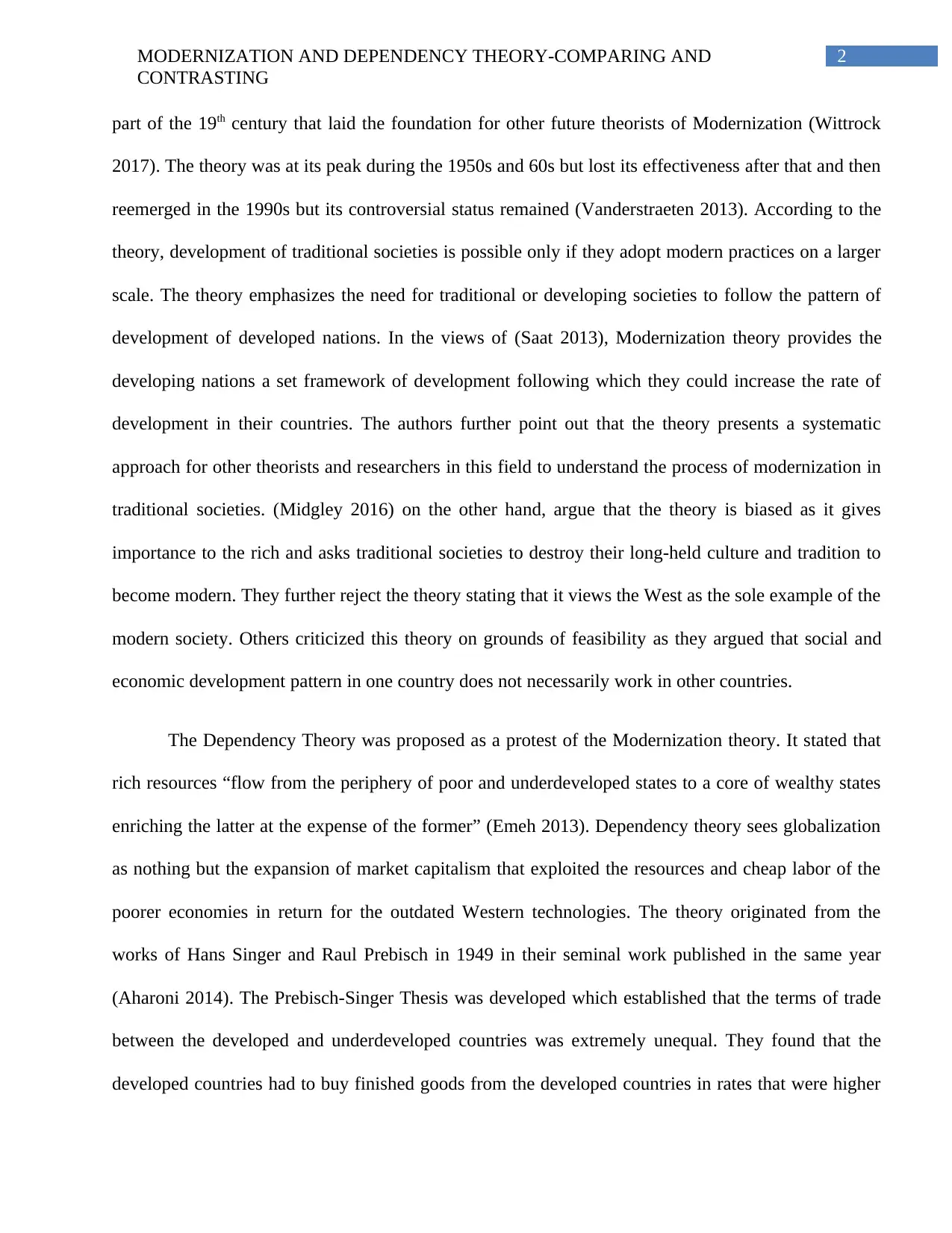
2MODERNIZATION AND DEPENDENCY THEORY-COMPARING AND
CONTRASTING
part of the 19th century that laid the foundation for other future theorists of Modernization (Wittrock
2017). The theory was at its peak during the 1950s and 60s but lost its effectiveness after that and then
reemerged in the 1990s but its controversial status remained (Vanderstraeten 2013). According to the
theory, development of traditional societies is possible only if they adopt modern practices on a larger
scale. The theory emphasizes the need for traditional or developing societies to follow the pattern of
development of developed nations. In the views of (Saat 2013), Modernization theory provides the
developing nations a set framework of development following which they could increase the rate of
development in their countries. The authors further point out that the theory presents a systematic
approach for other theorists and researchers in this field to understand the process of modernization in
traditional societies. (Midgley 2016) on the other hand, argue that the theory is biased as it gives
importance to the rich and asks traditional societies to destroy their long-held culture and tradition to
become modern. They further reject the theory stating that it views the West as the sole example of the
modern society. Others criticized this theory on grounds of feasibility as they argued that social and
economic development pattern in one country does not necessarily work in other countries.
The Dependency Theory was proposed as a protest of the Modernization theory. It stated that
rich resources “flow from the periphery of poor and underdeveloped states to a core of wealthy states
enriching the latter at the expense of the former” (Emeh 2013). Dependency theory sees globalization
as nothing but the expansion of market capitalism that exploited the resources and cheap labor of the
poorer economies in return for the outdated Western technologies. The theory originated from the
works of Hans Singer and Raul Prebisch in 1949 in their seminal work published in the same year
(Aharoni 2014). The Prebisch-Singer Thesis was developed which established that the terms of trade
between the developed and underdeveloped countries was extremely unequal. They found that the
developed countries had to buy finished goods from the developed countries in rates that were higher
CONTRASTING
part of the 19th century that laid the foundation for other future theorists of Modernization (Wittrock
2017). The theory was at its peak during the 1950s and 60s but lost its effectiveness after that and then
reemerged in the 1990s but its controversial status remained (Vanderstraeten 2013). According to the
theory, development of traditional societies is possible only if they adopt modern practices on a larger
scale. The theory emphasizes the need for traditional or developing societies to follow the pattern of
development of developed nations. In the views of (Saat 2013), Modernization theory provides the
developing nations a set framework of development following which they could increase the rate of
development in their countries. The authors further point out that the theory presents a systematic
approach for other theorists and researchers in this field to understand the process of modernization in
traditional societies. (Midgley 2016) on the other hand, argue that the theory is biased as it gives
importance to the rich and asks traditional societies to destroy their long-held culture and tradition to
become modern. They further reject the theory stating that it views the West as the sole example of the
modern society. Others criticized this theory on grounds of feasibility as they argued that social and
economic development pattern in one country does not necessarily work in other countries.
The Dependency Theory was proposed as a protest of the Modernization theory. It stated that
rich resources “flow from the periphery of poor and underdeveloped states to a core of wealthy states
enriching the latter at the expense of the former” (Emeh 2013). Dependency theory sees globalization
as nothing but the expansion of market capitalism that exploited the resources and cheap labor of the
poorer economies in return for the outdated Western technologies. The theory originated from the
works of Hans Singer and Raul Prebisch in 1949 in their seminal work published in the same year
(Aharoni 2014). The Prebisch-Singer Thesis was developed which established that the terms of trade
between the developed and underdeveloped countries was extremely unequal. They found that the
developed countries had to buy finished goods from the developed countries in rates that were higher
⊘ This is a preview!⊘
Do you want full access?
Subscribe today to unlock all pages.

Trusted by 1+ million students worldwide
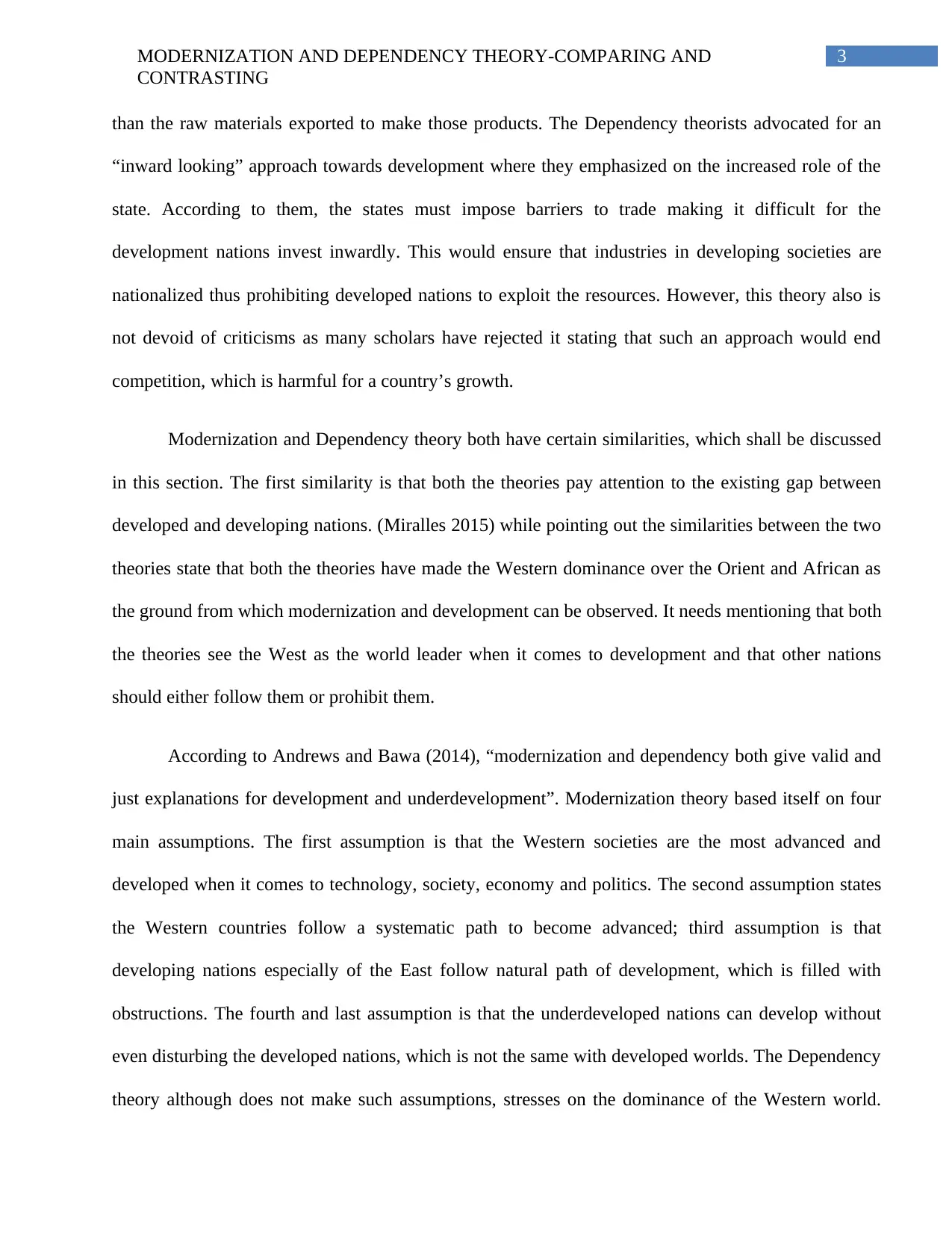
3MODERNIZATION AND DEPENDENCY THEORY-COMPARING AND
CONTRASTING
than the raw materials exported to make those products. The Dependency theorists advocated for an
“inward looking” approach towards development where they emphasized on the increased role of the
state. According to them, the states must impose barriers to trade making it difficult for the
development nations invest inwardly. This would ensure that industries in developing societies are
nationalized thus prohibiting developed nations to exploit the resources. However, this theory also is
not devoid of criticisms as many scholars have rejected it stating that such an approach would end
competition, which is harmful for a country’s growth.
Modernization and Dependency theory both have certain similarities, which shall be discussed
in this section. The first similarity is that both the theories pay attention to the existing gap between
developed and developing nations. (Miralles 2015) while pointing out the similarities between the two
theories state that both the theories have made the Western dominance over the Orient and African as
the ground from which modernization and development can be observed. It needs mentioning that both
the theories see the West as the world leader when it comes to development and that other nations
should either follow them or prohibit them.
According to Andrews and Bawa (2014), “modernization and dependency both give valid and
just explanations for development and underdevelopment”. Modernization theory based itself on four
main assumptions. The first assumption is that the Western societies are the most advanced and
developed when it comes to technology, society, economy and politics. The second assumption states
the Western countries follow a systematic path to become advanced; third assumption is that
developing nations especially of the East follow natural path of development, which is filled with
obstructions. The fourth and last assumption is that the underdeveloped nations can develop without
even disturbing the developed nations, which is not the same with developed worlds. The Dependency
theory although does not make such assumptions, stresses on the dominance of the Western world.
CONTRASTING
than the raw materials exported to make those products. The Dependency theorists advocated for an
“inward looking” approach towards development where they emphasized on the increased role of the
state. According to them, the states must impose barriers to trade making it difficult for the
development nations invest inwardly. This would ensure that industries in developing societies are
nationalized thus prohibiting developed nations to exploit the resources. However, this theory also is
not devoid of criticisms as many scholars have rejected it stating that such an approach would end
competition, which is harmful for a country’s growth.
Modernization and Dependency theory both have certain similarities, which shall be discussed
in this section. The first similarity is that both the theories pay attention to the existing gap between
developed and developing nations. (Miralles 2015) while pointing out the similarities between the two
theories state that both the theories have made the Western dominance over the Orient and African as
the ground from which modernization and development can be observed. It needs mentioning that both
the theories see the West as the world leader when it comes to development and that other nations
should either follow them or prohibit them.
According to Andrews and Bawa (2014), “modernization and dependency both give valid and
just explanations for development and underdevelopment”. Modernization theory based itself on four
main assumptions. The first assumption is that the Western societies are the most advanced and
developed when it comes to technology, society, economy and politics. The second assumption states
the Western countries follow a systematic path to become advanced; third assumption is that
developing nations especially of the East follow natural path of development, which is filled with
obstructions. The fourth and last assumption is that the underdeveloped nations can develop without
even disturbing the developed nations, which is not the same with developed worlds. The Dependency
theory although does not make such assumptions, stresses on the dominance of the Western world.
Paraphrase This Document
Need a fresh take? Get an instant paraphrase of this document with our AI Paraphraser
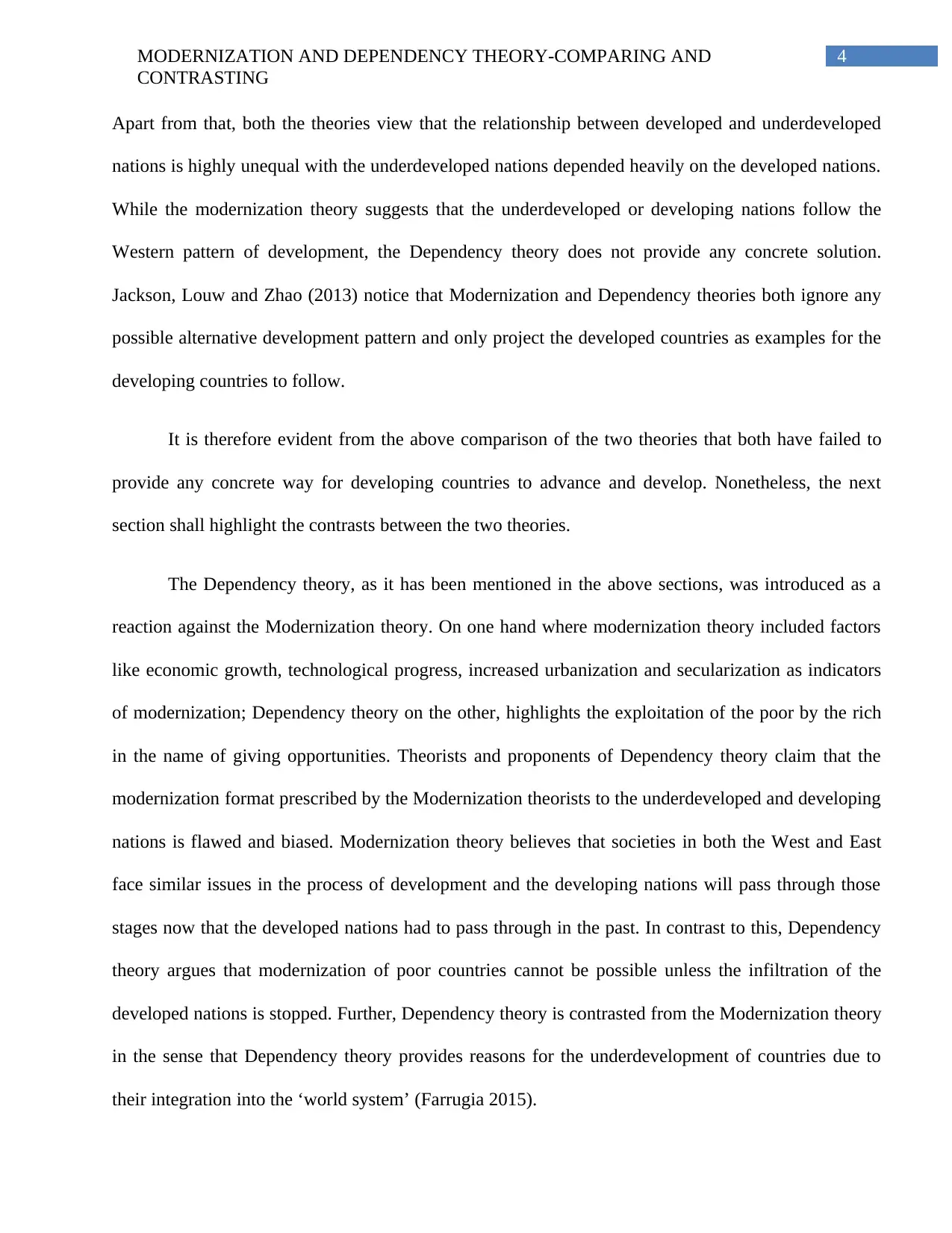
4MODERNIZATION AND DEPENDENCY THEORY-COMPARING AND
CONTRASTING
Apart from that, both the theories view that the relationship between developed and underdeveloped
nations is highly unequal with the underdeveloped nations depended heavily on the developed nations.
While the modernization theory suggests that the underdeveloped or developing nations follow the
Western pattern of development, the Dependency theory does not provide any concrete solution.
Jackson, Louw and Zhao (2013) notice that Modernization and Dependency theories both ignore any
possible alternative development pattern and only project the developed countries as examples for the
developing countries to follow.
It is therefore evident from the above comparison of the two theories that both have failed to
provide any concrete way for developing countries to advance and develop. Nonetheless, the next
section shall highlight the contrasts between the two theories.
The Dependency theory, as it has been mentioned in the above sections, was introduced as a
reaction against the Modernization theory. On one hand where modernization theory included factors
like economic growth, technological progress, increased urbanization and secularization as indicators
of modernization; Dependency theory on the other, highlights the exploitation of the poor by the rich
in the name of giving opportunities. Theorists and proponents of Dependency theory claim that the
modernization format prescribed by the Modernization theorists to the underdeveloped and developing
nations is flawed and biased. Modernization theory believes that societies in both the West and East
face similar issues in the process of development and the developing nations will pass through those
stages now that the developed nations had to pass through in the past. In contrast to this, Dependency
theory argues that modernization of poor countries cannot be possible unless the infiltration of the
developed nations is stopped. Further, Dependency theory is contrasted from the Modernization theory
in the sense that Dependency theory provides reasons for the underdevelopment of countries due to
their integration into the ‘world system’ (Farrugia 2015).
CONTRASTING
Apart from that, both the theories view that the relationship between developed and underdeveloped
nations is highly unequal with the underdeveloped nations depended heavily on the developed nations.
While the modernization theory suggests that the underdeveloped or developing nations follow the
Western pattern of development, the Dependency theory does not provide any concrete solution.
Jackson, Louw and Zhao (2013) notice that Modernization and Dependency theories both ignore any
possible alternative development pattern and only project the developed countries as examples for the
developing countries to follow.
It is therefore evident from the above comparison of the two theories that both have failed to
provide any concrete way for developing countries to advance and develop. Nonetheless, the next
section shall highlight the contrasts between the two theories.
The Dependency theory, as it has been mentioned in the above sections, was introduced as a
reaction against the Modernization theory. On one hand where modernization theory included factors
like economic growth, technological progress, increased urbanization and secularization as indicators
of modernization; Dependency theory on the other, highlights the exploitation of the poor by the rich
in the name of giving opportunities. Theorists and proponents of Dependency theory claim that the
modernization format prescribed by the Modernization theorists to the underdeveloped and developing
nations is flawed and biased. Modernization theory believes that societies in both the West and East
face similar issues in the process of development and the developing nations will pass through those
stages now that the developed nations had to pass through in the past. In contrast to this, Dependency
theory argues that modernization of poor countries cannot be possible unless the infiltration of the
developed nations is stopped. Further, Dependency theory is contrasted from the Modernization theory
in the sense that Dependency theory provides reasons for the underdevelopment of countries due to
their integration into the ‘world system’ (Farrugia 2015).
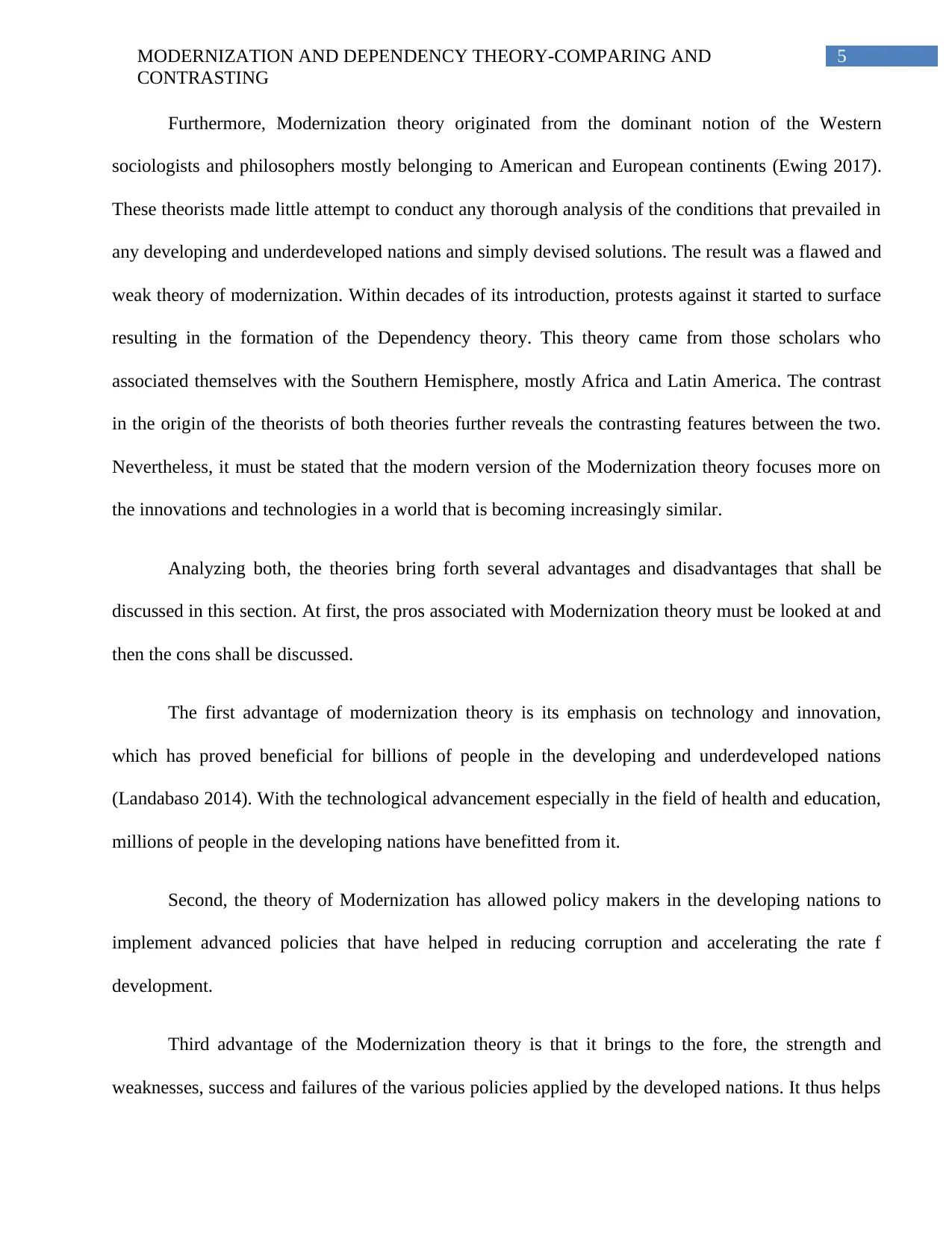
5MODERNIZATION AND DEPENDENCY THEORY-COMPARING AND
CONTRASTING
Furthermore, Modernization theory originated from the dominant notion of the Western
sociologists and philosophers mostly belonging to American and European continents (Ewing 2017).
These theorists made little attempt to conduct any thorough analysis of the conditions that prevailed in
any developing and underdeveloped nations and simply devised solutions. The result was a flawed and
weak theory of modernization. Within decades of its introduction, protests against it started to surface
resulting in the formation of the Dependency theory. This theory came from those scholars who
associated themselves with the Southern Hemisphere, mostly Africa and Latin America. The contrast
in the origin of the theorists of both theories further reveals the contrasting features between the two.
Nevertheless, it must be stated that the modern version of the Modernization theory focuses more on
the innovations and technologies in a world that is becoming increasingly similar.
Analyzing both, the theories bring forth several advantages and disadvantages that shall be
discussed in this section. At first, the pros associated with Modernization theory must be looked at and
then the cons shall be discussed.
The first advantage of modernization theory is its emphasis on technology and innovation,
which has proved beneficial for billions of people in the developing and underdeveloped nations
(Landabaso 2014). With the technological advancement especially in the field of health and education,
millions of people in the developing nations have benefitted from it.
Second, the theory of Modernization has allowed policy makers in the developing nations to
implement advanced policies that have helped in reducing corruption and accelerating the rate f
development.
Third advantage of the Modernization theory is that it brings to the fore, the strength and
weaknesses, success and failures of the various policies applied by the developed nations. It thus helps
CONTRASTING
Furthermore, Modernization theory originated from the dominant notion of the Western
sociologists and philosophers mostly belonging to American and European continents (Ewing 2017).
These theorists made little attempt to conduct any thorough analysis of the conditions that prevailed in
any developing and underdeveloped nations and simply devised solutions. The result was a flawed and
weak theory of modernization. Within decades of its introduction, protests against it started to surface
resulting in the formation of the Dependency theory. This theory came from those scholars who
associated themselves with the Southern Hemisphere, mostly Africa and Latin America. The contrast
in the origin of the theorists of both theories further reveals the contrasting features between the two.
Nevertheless, it must be stated that the modern version of the Modernization theory focuses more on
the innovations and technologies in a world that is becoming increasingly similar.
Analyzing both, the theories bring forth several advantages and disadvantages that shall be
discussed in this section. At first, the pros associated with Modernization theory must be looked at and
then the cons shall be discussed.
The first advantage of modernization theory is its emphasis on technology and innovation,
which has proved beneficial for billions of people in the developing and underdeveloped nations
(Landabaso 2014). With the technological advancement especially in the field of health and education,
millions of people in the developing nations have benefitted from it.
Second, the theory of Modernization has allowed policy makers in the developing nations to
implement advanced policies that have helped in reducing corruption and accelerating the rate f
development.
Third advantage of the Modernization theory is that it brings to the fore, the strength and
weaknesses, success and failures of the various policies applied by the developed nations. It thus helps
⊘ This is a preview!⊘
Do you want full access?
Subscribe today to unlock all pages.

Trusted by 1+ million students worldwide
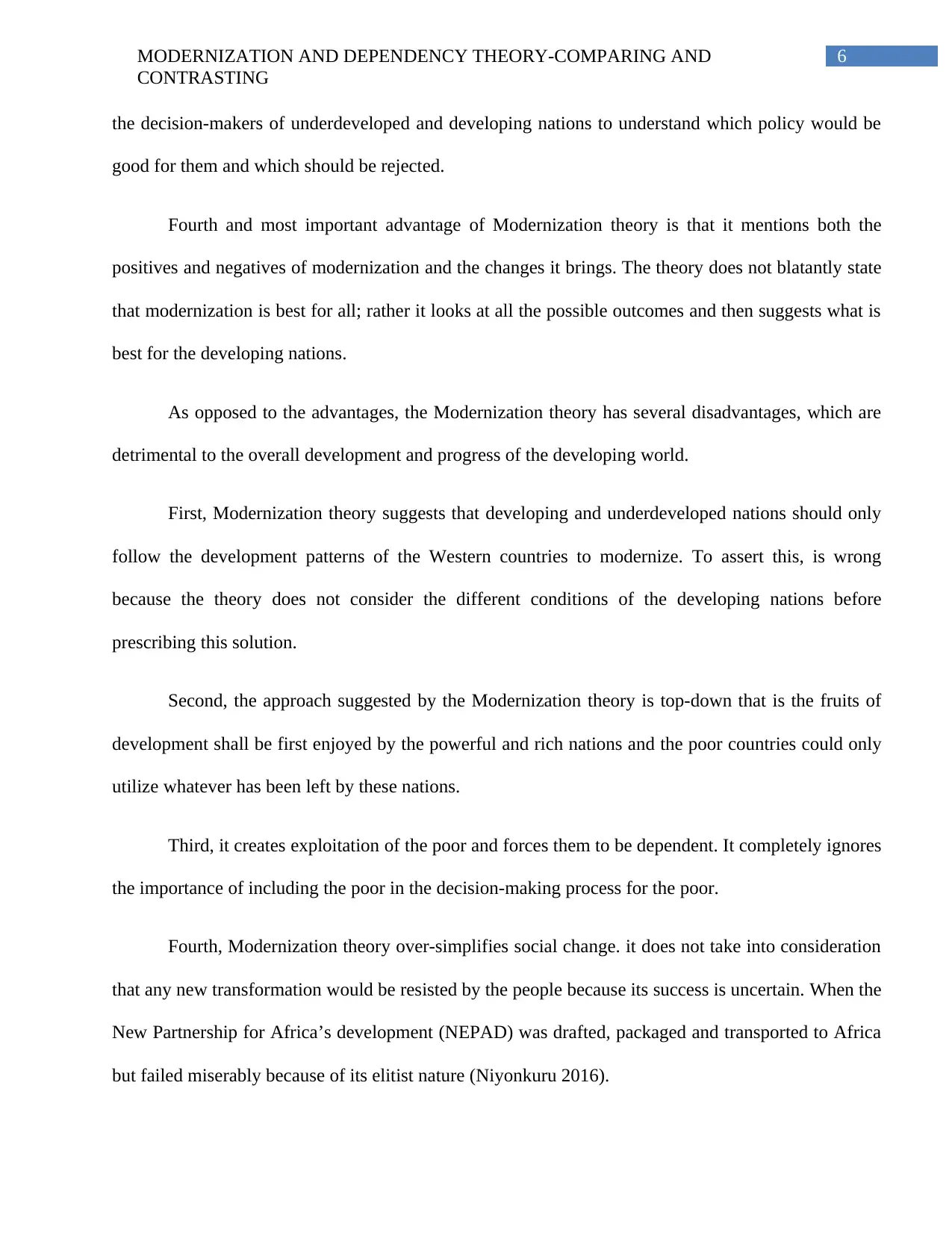
6MODERNIZATION AND DEPENDENCY THEORY-COMPARING AND
CONTRASTING
the decision-makers of underdeveloped and developing nations to understand which policy would be
good for them and which should be rejected.
Fourth and most important advantage of Modernization theory is that it mentions both the
positives and negatives of modernization and the changes it brings. The theory does not blatantly state
that modernization is best for all; rather it looks at all the possible outcomes and then suggests what is
best for the developing nations.
As opposed to the advantages, the Modernization theory has several disadvantages, which are
detrimental to the overall development and progress of the developing world.
First, Modernization theory suggests that developing and underdeveloped nations should only
follow the development patterns of the Western countries to modernize. To assert this, is wrong
because the theory does not consider the different conditions of the developing nations before
prescribing this solution.
Second, the approach suggested by the Modernization theory is top-down that is the fruits of
development shall be first enjoyed by the powerful and rich nations and the poor countries could only
utilize whatever has been left by these nations.
Third, it creates exploitation of the poor and forces them to be dependent. It completely ignores
the importance of including the poor in the decision-making process for the poor.
Fourth, Modernization theory over-simplifies social change. it does not take into consideration
that any new transformation would be resisted by the people because its success is uncertain. When the
New Partnership for Africa’s development (NEPAD) was drafted, packaged and transported to Africa
but failed miserably because of its elitist nature (Niyonkuru 2016).
CONTRASTING
the decision-makers of underdeveloped and developing nations to understand which policy would be
good for them and which should be rejected.
Fourth and most important advantage of Modernization theory is that it mentions both the
positives and negatives of modernization and the changes it brings. The theory does not blatantly state
that modernization is best for all; rather it looks at all the possible outcomes and then suggests what is
best for the developing nations.
As opposed to the advantages, the Modernization theory has several disadvantages, which are
detrimental to the overall development and progress of the developing world.
First, Modernization theory suggests that developing and underdeveloped nations should only
follow the development patterns of the Western countries to modernize. To assert this, is wrong
because the theory does not consider the different conditions of the developing nations before
prescribing this solution.
Second, the approach suggested by the Modernization theory is top-down that is the fruits of
development shall be first enjoyed by the powerful and rich nations and the poor countries could only
utilize whatever has been left by these nations.
Third, it creates exploitation of the poor and forces them to be dependent. It completely ignores
the importance of including the poor in the decision-making process for the poor.
Fourth, Modernization theory over-simplifies social change. it does not take into consideration
that any new transformation would be resisted by the people because its success is uncertain. When the
New Partnership for Africa’s development (NEPAD) was drafted, packaged and transported to Africa
but failed miserably because of its elitist nature (Niyonkuru 2016).
Paraphrase This Document
Need a fresh take? Get an instant paraphrase of this document with our AI Paraphraser
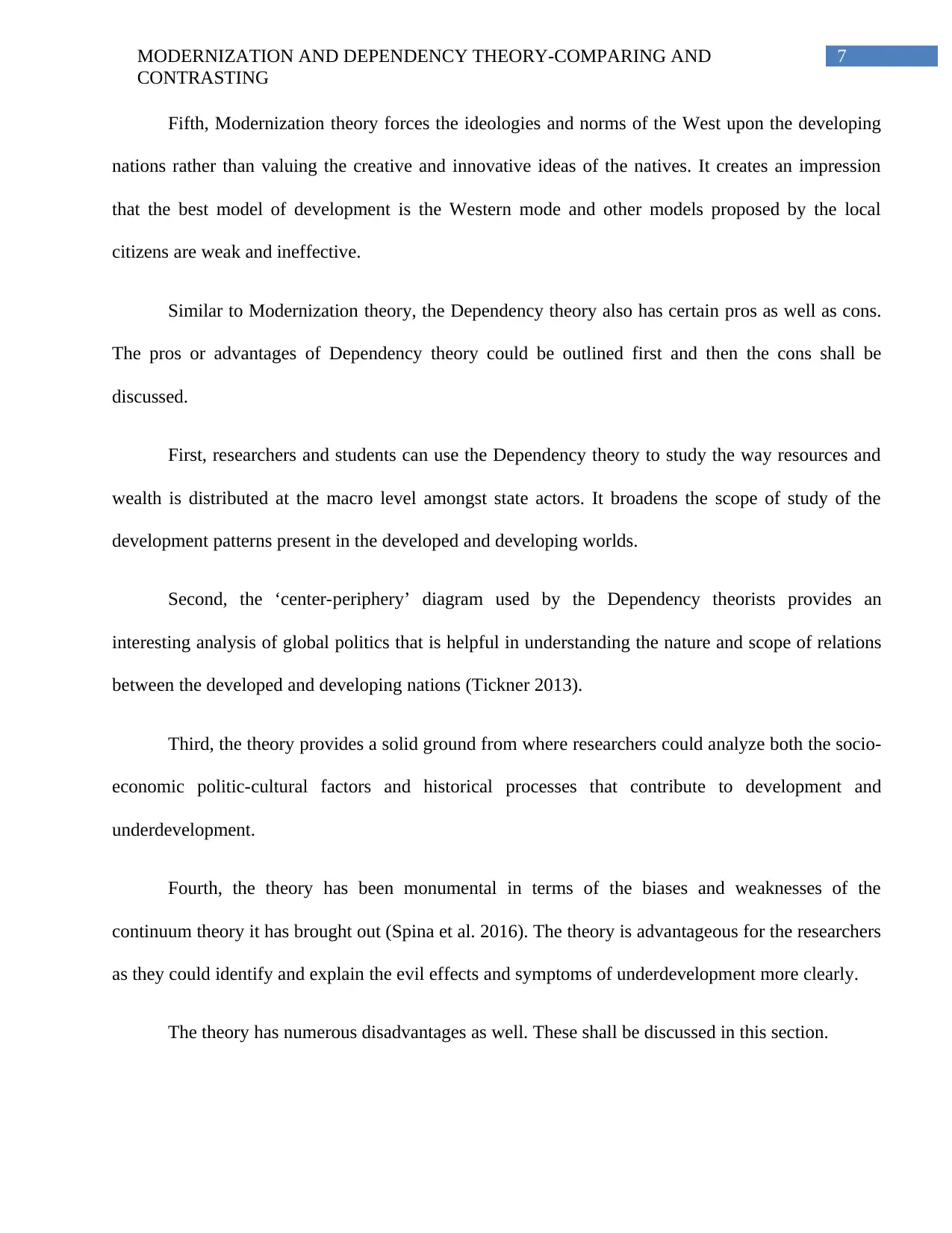
7MODERNIZATION AND DEPENDENCY THEORY-COMPARING AND
CONTRASTING
Fifth, Modernization theory forces the ideologies and norms of the West upon the developing
nations rather than valuing the creative and innovative ideas of the natives. It creates an impression
that the best model of development is the Western mode and other models proposed by the local
citizens are weak and ineffective.
Similar to Modernization theory, the Dependency theory also has certain pros as well as cons.
The pros or advantages of Dependency theory could be outlined first and then the cons shall be
discussed.
First, researchers and students can use the Dependency theory to study the way resources and
wealth is distributed at the macro level amongst state actors. It broadens the scope of study of the
development patterns present in the developed and developing worlds.
Second, the ‘center-periphery’ diagram used by the Dependency theorists provides an
interesting analysis of global politics that is helpful in understanding the nature and scope of relations
between the developed and developing nations (Tickner 2013).
Third, the theory provides a solid ground from where researchers could analyze both the socio-
economic politic-cultural factors and historical processes that contribute to development and
underdevelopment.
Fourth, the theory has been monumental in terms of the biases and weaknesses of the
continuum theory it has brought out (Spina et al. 2016). The theory is advantageous for the researchers
as they could identify and explain the evil effects and symptoms of underdevelopment more clearly.
The theory has numerous disadvantages as well. These shall be discussed in this section.
CONTRASTING
Fifth, Modernization theory forces the ideologies and norms of the West upon the developing
nations rather than valuing the creative and innovative ideas of the natives. It creates an impression
that the best model of development is the Western mode and other models proposed by the local
citizens are weak and ineffective.
Similar to Modernization theory, the Dependency theory also has certain pros as well as cons.
The pros or advantages of Dependency theory could be outlined first and then the cons shall be
discussed.
First, researchers and students can use the Dependency theory to study the way resources and
wealth is distributed at the macro level amongst state actors. It broadens the scope of study of the
development patterns present in the developed and developing worlds.
Second, the ‘center-periphery’ diagram used by the Dependency theorists provides an
interesting analysis of global politics that is helpful in understanding the nature and scope of relations
between the developed and developing nations (Tickner 2013).
Third, the theory provides a solid ground from where researchers could analyze both the socio-
economic politic-cultural factors and historical processes that contribute to development and
underdevelopment.
Fourth, the theory has been monumental in terms of the biases and weaknesses of the
continuum theory it has brought out (Spina et al. 2016). The theory is advantageous for the researchers
as they could identify and explain the evil effects and symptoms of underdevelopment more clearly.
The theory has numerous disadvantages as well. These shall be discussed in this section.
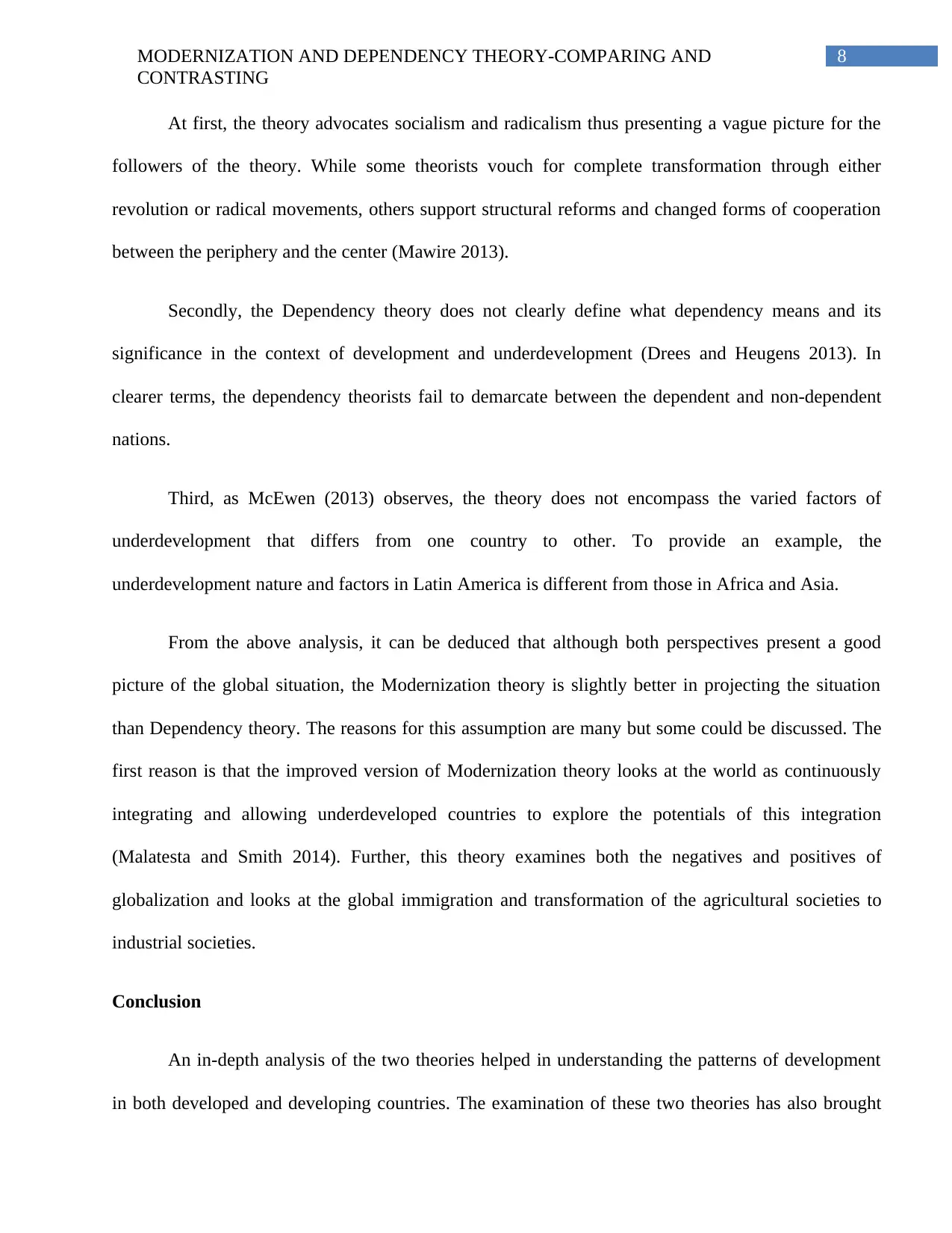
8MODERNIZATION AND DEPENDENCY THEORY-COMPARING AND
CONTRASTING
At first, the theory advocates socialism and radicalism thus presenting a vague picture for the
followers of the theory. While some theorists vouch for complete transformation through either
revolution or radical movements, others support structural reforms and changed forms of cooperation
between the periphery and the center (Mawire 2013).
Secondly, the Dependency theory does not clearly define what dependency means and its
significance in the context of development and underdevelopment (Drees and Heugens 2013). In
clearer terms, the dependency theorists fail to demarcate between the dependent and non-dependent
nations.
Third, as McEwen (2013) observes, the theory does not encompass the varied factors of
underdevelopment that differs from one country to other. To provide an example, the
underdevelopment nature and factors in Latin America is different from those in Africa and Asia.
From the above analysis, it can be deduced that although both perspectives present a good
picture of the global situation, the Modernization theory is slightly better in projecting the situation
than Dependency theory. The reasons for this assumption are many but some could be discussed. The
first reason is that the improved version of Modernization theory looks at the world as continuously
integrating and allowing underdeveloped countries to explore the potentials of this integration
(Malatesta and Smith 2014). Further, this theory examines both the negatives and positives of
globalization and looks at the global immigration and transformation of the agricultural societies to
industrial societies.
Conclusion
An in-depth analysis of the two theories helped in understanding the patterns of development
in both developed and developing countries. The examination of these two theories has also brought
CONTRASTING
At first, the theory advocates socialism and radicalism thus presenting a vague picture for the
followers of the theory. While some theorists vouch for complete transformation through either
revolution or radical movements, others support structural reforms and changed forms of cooperation
between the periphery and the center (Mawire 2013).
Secondly, the Dependency theory does not clearly define what dependency means and its
significance in the context of development and underdevelopment (Drees and Heugens 2013). In
clearer terms, the dependency theorists fail to demarcate between the dependent and non-dependent
nations.
Third, as McEwen (2013) observes, the theory does not encompass the varied factors of
underdevelopment that differs from one country to other. To provide an example, the
underdevelopment nature and factors in Latin America is different from those in Africa and Asia.
From the above analysis, it can be deduced that although both perspectives present a good
picture of the global situation, the Modernization theory is slightly better in projecting the situation
than Dependency theory. The reasons for this assumption are many but some could be discussed. The
first reason is that the improved version of Modernization theory looks at the world as continuously
integrating and allowing underdeveloped countries to explore the potentials of this integration
(Malatesta and Smith 2014). Further, this theory examines both the negatives and positives of
globalization and looks at the global immigration and transformation of the agricultural societies to
industrial societies.
Conclusion
An in-depth analysis of the two theories helped in understanding the patterns of development
in both developed and developing countries. The examination of these two theories has also brought
⊘ This is a preview!⊘
Do you want full access?
Subscribe today to unlock all pages.

Trusted by 1+ million students worldwide
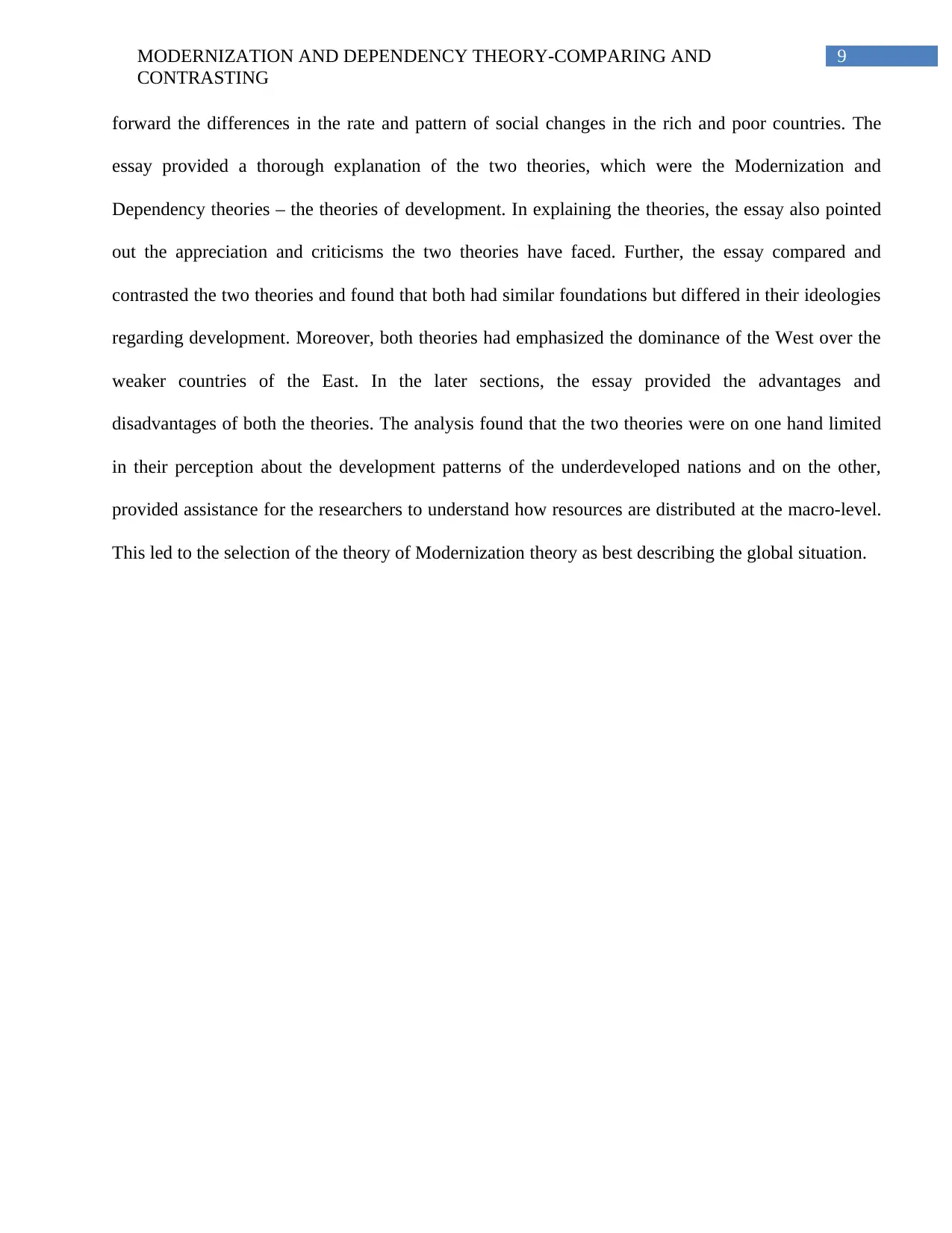
9MODERNIZATION AND DEPENDENCY THEORY-COMPARING AND
CONTRASTING
forward the differences in the rate and pattern of social changes in the rich and poor countries. The
essay provided a thorough explanation of the two theories, which were the Modernization and
Dependency theories – the theories of development. In explaining the theories, the essay also pointed
out the appreciation and criticisms the two theories have faced. Further, the essay compared and
contrasted the two theories and found that both had similar foundations but differed in their ideologies
regarding development. Moreover, both theories had emphasized the dominance of the West over the
weaker countries of the East. In the later sections, the essay provided the advantages and
disadvantages of both the theories. The analysis found that the two theories were on one hand limited
in their perception about the development patterns of the underdeveloped nations and on the other,
provided assistance for the researchers to understand how resources are distributed at the macro-level.
This led to the selection of the theory of Modernization theory as best describing the global situation.
CONTRASTING
forward the differences in the rate and pattern of social changes in the rich and poor countries. The
essay provided a thorough explanation of the two theories, which were the Modernization and
Dependency theories – the theories of development. In explaining the theories, the essay also pointed
out the appreciation and criticisms the two theories have faced. Further, the essay compared and
contrasted the two theories and found that both had similar foundations but differed in their ideologies
regarding development. Moreover, both theories had emphasized the dominance of the West over the
weaker countries of the East. In the later sections, the essay provided the advantages and
disadvantages of both the theories. The analysis found that the two theories were on one hand limited
in their perception about the development patterns of the underdeveloped nations and on the other,
provided assistance for the researchers to understand how resources are distributed at the macro-level.
This led to the selection of the theory of Modernization theory as best describing the global situation.
Paraphrase This Document
Need a fresh take? Get an instant paraphrase of this document with our AI Paraphraser
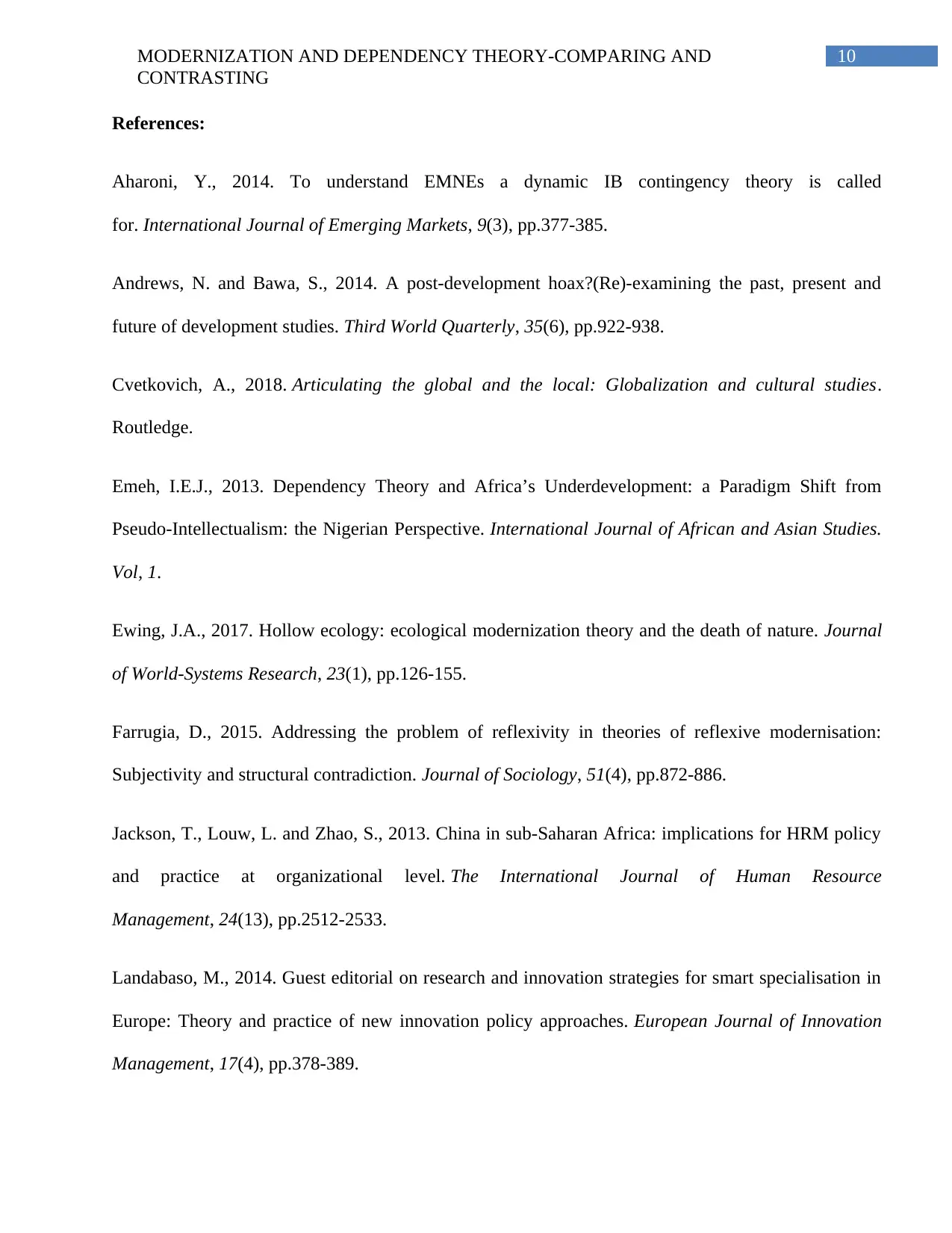
10MODERNIZATION AND DEPENDENCY THEORY-COMPARING AND
CONTRASTING
References:
Aharoni, Y., 2014. To understand EMNEs a dynamic IB contingency theory is called
for. International Journal of Emerging Markets, 9(3), pp.377-385.
Andrews, N. and Bawa, S., 2014. A post-development hoax?(Re)-examining the past, present and
future of development studies. Third World Quarterly, 35(6), pp.922-938.
Cvetkovich, A., 2018. Articulating the global and the local: Globalization and cultural studies.
Routledge.
Emeh, I.E.J., 2013. Dependency Theory and Africa’s Underdevelopment: a Paradigm Shift from
Pseudo-Intellectualism: the Nigerian Perspective. International Journal of African and Asian Studies.
Vol, 1.
Ewing, J.A., 2017. Hollow ecology: ecological modernization theory and the death of nature. Journal
of World-Systems Research, 23(1), pp.126-155.
Farrugia, D., 2015. Addressing the problem of reflexivity in theories of reflexive modernisation:
Subjectivity and structural contradiction. Journal of Sociology, 51(4), pp.872-886.
Jackson, T., Louw, L. and Zhao, S., 2013. China in sub-Saharan Africa: implications for HRM policy
and practice at organizational level. The International Journal of Human Resource
Management, 24(13), pp.2512-2533.
Landabaso, M., 2014. Guest editorial on research and innovation strategies for smart specialisation in
Europe: Theory and practice of new innovation policy approaches. European Journal of Innovation
Management, 17(4), pp.378-389.
CONTRASTING
References:
Aharoni, Y., 2014. To understand EMNEs a dynamic IB contingency theory is called
for. International Journal of Emerging Markets, 9(3), pp.377-385.
Andrews, N. and Bawa, S., 2014. A post-development hoax?(Re)-examining the past, present and
future of development studies. Third World Quarterly, 35(6), pp.922-938.
Cvetkovich, A., 2018. Articulating the global and the local: Globalization and cultural studies.
Routledge.
Emeh, I.E.J., 2013. Dependency Theory and Africa’s Underdevelopment: a Paradigm Shift from
Pseudo-Intellectualism: the Nigerian Perspective. International Journal of African and Asian Studies.
Vol, 1.
Ewing, J.A., 2017. Hollow ecology: ecological modernization theory and the death of nature. Journal
of World-Systems Research, 23(1), pp.126-155.
Farrugia, D., 2015. Addressing the problem of reflexivity in theories of reflexive modernisation:
Subjectivity and structural contradiction. Journal of Sociology, 51(4), pp.872-886.
Jackson, T., Louw, L. and Zhao, S., 2013. China in sub-Saharan Africa: implications for HRM policy
and practice at organizational level. The International Journal of Human Resource
Management, 24(13), pp.2512-2533.
Landabaso, M., 2014. Guest editorial on research and innovation strategies for smart specialisation in
Europe: Theory and practice of new innovation policy approaches. European Journal of Innovation
Management, 17(4), pp.378-389.
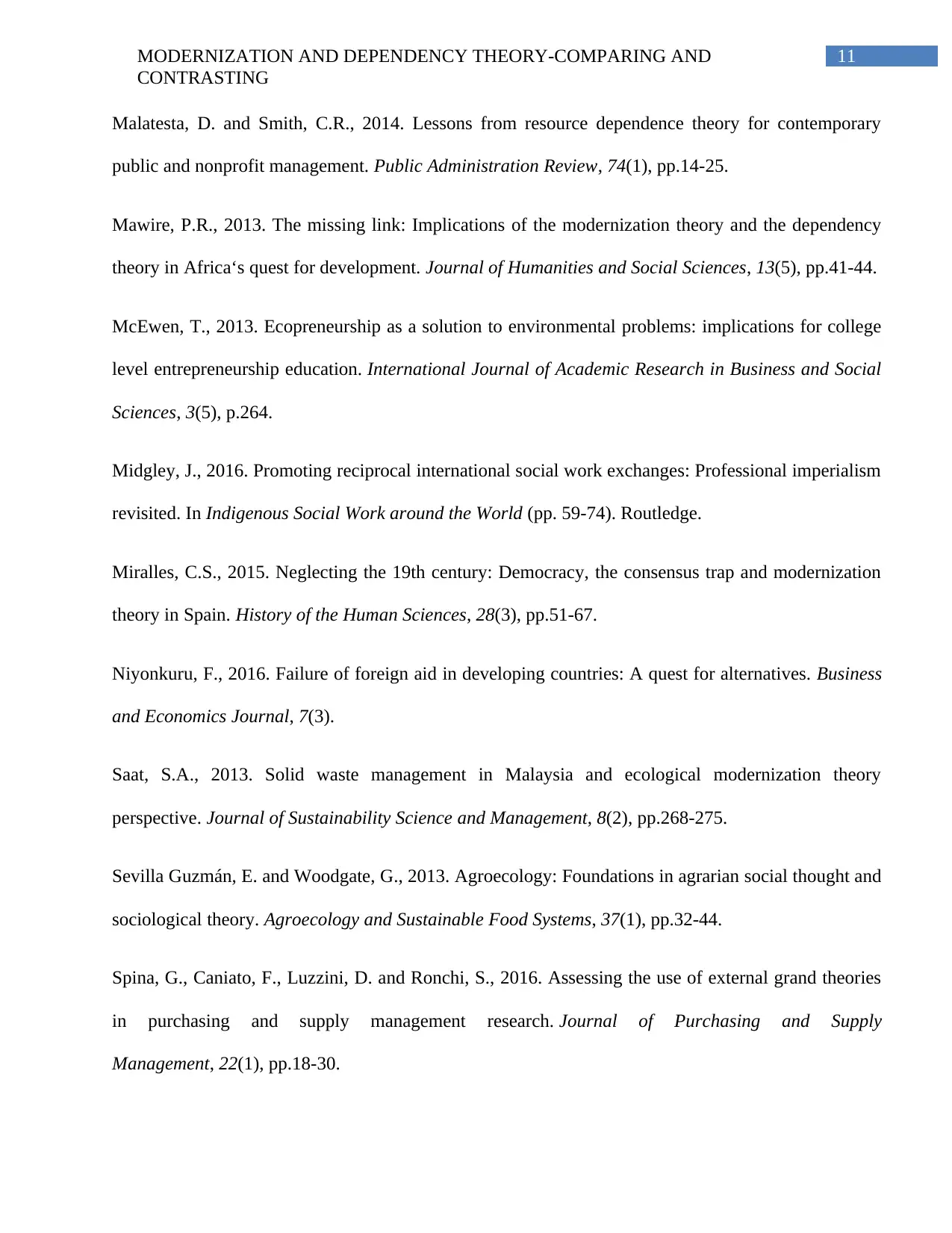
11MODERNIZATION AND DEPENDENCY THEORY-COMPARING AND
CONTRASTING
Malatesta, D. and Smith, C.R., 2014. Lessons from resource dependence theory for contemporary
public and nonprofit management. Public Administration Review, 74(1), pp.14-25.
Mawire, P.R., 2013. The missing link: Implications of the modernization theory and the dependency
theory in Africa‘s quest for development. Journal of Humanities and Social Sciences, 13(5), pp.41-44.
McEwen, T., 2013. Ecopreneurship as a solution to environmental problems: implications for college
level entrepreneurship education. International Journal of Academic Research in Business and Social
Sciences, 3(5), p.264.
Midgley, J., 2016. Promoting reciprocal international social work exchanges: Professional imperialism
revisited. In Indigenous Social Work around the World (pp. 59-74). Routledge.
Miralles, C.S., 2015. Neglecting the 19th century: Democracy, the consensus trap and modernization
theory in Spain. History of the Human Sciences, 28(3), pp.51-67.
Niyonkuru, F., 2016. Failure of foreign aid in developing countries: A quest for alternatives. Business
and Economics Journal, 7(3).
Saat, S.A., 2013. Solid waste management in Malaysia and ecological modernization theory
perspective. Journal of Sustainability Science and Management, 8(2), pp.268-275.
Sevilla Guzmán, E. and Woodgate, G., 2013. Agroecology: Foundations in agrarian social thought and
sociological theory. Agroecology and Sustainable Food Systems, 37(1), pp.32-44.
Spina, G., Caniato, F., Luzzini, D. and Ronchi, S., 2016. Assessing the use of external grand theories
in purchasing and supply management research. Journal of Purchasing and Supply
Management, 22(1), pp.18-30.
CONTRASTING
Malatesta, D. and Smith, C.R., 2014. Lessons from resource dependence theory for contemporary
public and nonprofit management. Public Administration Review, 74(1), pp.14-25.
Mawire, P.R., 2013. The missing link: Implications of the modernization theory and the dependency
theory in Africa‘s quest for development. Journal of Humanities and Social Sciences, 13(5), pp.41-44.
McEwen, T., 2013. Ecopreneurship as a solution to environmental problems: implications for college
level entrepreneurship education. International Journal of Academic Research in Business and Social
Sciences, 3(5), p.264.
Midgley, J., 2016. Promoting reciprocal international social work exchanges: Professional imperialism
revisited. In Indigenous Social Work around the World (pp. 59-74). Routledge.
Miralles, C.S., 2015. Neglecting the 19th century: Democracy, the consensus trap and modernization
theory in Spain. History of the Human Sciences, 28(3), pp.51-67.
Niyonkuru, F., 2016. Failure of foreign aid in developing countries: A quest for alternatives. Business
and Economics Journal, 7(3).
Saat, S.A., 2013. Solid waste management in Malaysia and ecological modernization theory
perspective. Journal of Sustainability Science and Management, 8(2), pp.268-275.
Sevilla Guzmán, E. and Woodgate, G., 2013. Agroecology: Foundations in agrarian social thought and
sociological theory. Agroecology and Sustainable Food Systems, 37(1), pp.32-44.
Spina, G., Caniato, F., Luzzini, D. and Ronchi, S., 2016. Assessing the use of external grand theories
in purchasing and supply management research. Journal of Purchasing and Supply
Management, 22(1), pp.18-30.
⊘ This is a preview!⊘
Do you want full access?
Subscribe today to unlock all pages.

Trusted by 1+ million students worldwide
1 out of 13
Related Documents
Your All-in-One AI-Powered Toolkit for Academic Success.
+13062052269
info@desklib.com
Available 24*7 on WhatsApp / Email
![[object Object]](/_next/static/media/star-bottom.7253800d.svg)
Unlock your academic potential
Copyright © 2020–2025 A2Z Services. All Rights Reserved. Developed and managed by ZUCOL.





